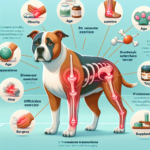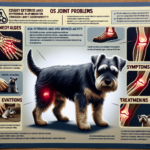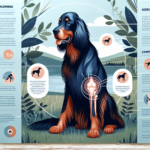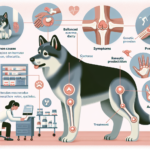Borzoi Joint Pain: Causes, Symptoms, Prevention, and Treatment
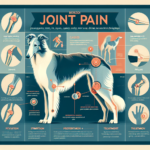
Introduction
The Borzoi, also known as the Russian Wolfhound, is a breed that exudes elegance and grace. Originating from Russia, this breed was initially developed for hunting wolves and other game. With their long, silky coats and slender, athletic build, Borzois are not only visually striking but also possess a gentle and affectionate temperament. Despite their aristocratic appearance, they are known for their speed and agility, making them excellent companions for active families.
Like many large breeds, Borzois are prone to certain health issues, with joint pain being a significant concern. Joint health is crucial for Borzois due to their active nature and the physical demands placed on their bodies. Understanding the causes, symptoms, prevention, and treatment of joint pain in Borzois can help owners ensure their pets lead healthy, pain-free lives.
Breed-Specific Joint Pain Risks
Genetic Predisposition
Borzois, like many purebred dogs, have a genetic predisposition to certain joint-related issues. Hip dysplasia, a condition where the hip joint doesn’t fit properly into the hip socket, is relatively common in this breed. Elbow dysplasia, where the elbow joint is malformed, can also occur. Additionally, Borzois may be prone to arthritis, a degenerative joint disease that causes inflammation and pain.
Age-Related Risks
As Borzois age, the risk of developing joint pain increases. While young Borzois are generally agile and active, older dogs may start to show signs of joint discomfort. Typically, joint issues may begin to appear around middle age, which for Borzois is between 5 to 7 years old. However, some dogs may show symptoms earlier or later, depending on their genetics and lifestyle.
Activity Level and Joint Stress
Borzois are known for their high energy levels and need for regular exercise. While this activity is essential for their overall health, it can also contribute to joint stress. Activities such as running, jumping, and playing can put significant strain on their joints, especially if done on hard surfaces. Owners should be mindful of their Borzoi’s activity levels and ensure they are not overexerting themselves.
Common Symptoms of Joint Pain in Borzois
General Symptoms
- Limping: One of the most noticeable signs of joint pain is limping or favoring one leg over another.
- Stiffness: Dogs with joint pain may appear stiff, especially after resting or sleeping.
- Reluctance to Move: A Borzoi with joint pain may be hesitant to engage in activities they once enjoyed, such as running or climbing stairs.
- Swelling: In some cases, the affected joint may appear swollen or feel warm to the touch.
- Behavioral Changes: Dogs in pain may become irritable, anxious, or less social.
Breed-Specific Symptoms
In Borzois, joint pain may manifest in specific ways due to their unique build and activity patterns. For instance, they may show a noticeable decrease in their speed and agility, which are typically their strong suits. Additionally, due to their long legs, any limping or stiffness can be more pronounced and easier to spot.
When to Consult a Vet
If you notice any of the above symptoms in your Borzoi, it’s essential to consult a veterinarian promptly. Early diagnosis and treatment can significantly improve your dog’s quality of life and prevent further joint damage. Regular veterinary check-ups are also crucial for monitoring your dog’s joint health and catching any issues early.
Preventive Measures for Joint Health
Exercise Recommendations
Regular exercise is vital for maintaining joint health in Borzois, but it should be done thoughtfully. Low-impact activities such as walking, swimming, and gentle play are excellent for keeping their joints flexible without causing excessive strain. Avoid high-impact activities like jumping or running on hard surfaces, which can exacerbate joint issues.
Dietary Suggestions
A balanced diet rich in essential nutrients can support joint health in Borzois. Look for dog foods that contain glucosamine and chondroitin, which are known to promote joint health. Omega-3 fatty acids, found in fish oil supplements, can also help reduce inflammation and support overall joint function. Always consult your veterinarian before adding any supplements to your dog’s diet.
Weight Management
Maintaining a healthy weight is crucial for reducing joint stress in Borzois. Excess weight can put additional pressure on the joints, exacerbating pain and discomfort. Ensure your Borzoi is fed a balanced diet and gets regular exercise to keep them at an optimal weight. Your veterinarian can provide specific guidelines based on your dog’s age, size, and activity level.
Early Screening and Monitoring
Early screening for joint issues can help catch problems before they become severe. Regular veterinary check-ups should include joint assessments, especially as your Borzoi ages. X-rays and other diagnostic tests can help identify issues like hip or elbow dysplasia early on, allowing for timely intervention and management.
Treatment Options for Joint Pain
Non-Surgical Treatments
For many Borzois, non-surgical treatments can effectively manage joint pain. These may include:
- Medications: Anti-inflammatory drugs and pain relievers can help reduce pain and inflammation.
- Physical Therapy: Exercises and therapies designed to improve joint function and reduce pain can be beneficial.
- Lifestyle Adjustments: Modifying your dog’s activity levels and providing a comfortable living environment can help manage symptoms.
Surgical Options
In severe cases, surgical intervention may be necessary. Common surgical options for joint pain in Borzois include:
- Hip Replacement: This surgery involves replacing the damaged hip joint with an artificial one.
- Arthroscopy: A minimally invasive procedure used to diagnose and treat joint issues.
- Joint Fusion: This surgery involves fusing the bones in a joint to reduce pain and improve stability.
Surgical options should be discussed thoroughly with your veterinarian to determine the best course of action for your Borzoi.
Alternative Therapies
Alternative therapies can also provide relief for Borzois with joint pain. These may include:
- Acupuncture: This traditional Chinese medicine technique can help reduce pain and improve joint function.
- Hydrotherapy: Water-based exercises can provide low-impact exercise and pain relief.
- Massage: Regular massages can help reduce muscle tension and improve circulation around the joints.
Lifestyle and Management Tips
Daily Care Routine
A consistent daily care routine can help manage and alleviate joint pain in Borzois. This may include:
- Providing regular, low-impact exercise to keep joints flexible.
- Feeding a balanced diet with joint-supporting nutrients.
- Administering any prescribed medications or supplements.
- Monitoring your dog’s weight and adjusting their diet as needed.
Modifying the Home Environment
Making your home more comfortable for a Borzoi with joint pain can significantly improve their quality of life. Consider the following modifications:
- Installing ramps to help your dog navigate stairs or get onto furniture.
- Providing orthopedic beds to support their joints while resting.
- Ensuring food and water bowls are at a comfortable height to reduce strain.
Long-Term Management
Long-term management of joint pain involves ongoing care and monitoring. Regular veterinary check-ups, consistent exercise, and a balanced diet are essential. Additionally, staying informed about new treatments and therapies can help you provide the best care for your Borzoi.
FAQs About Borzois and Joint Pain
What are the early signs of joint pain in Borzois?
Early signs of joint pain in Borzois include limping, stiffness, reluctance to move, and behavioral changes such as irritability or anxiety.
Can joint pain in Borzois be prevented?
While it may not be entirely preventable, joint pain in Borzois can be managed and minimized through regular exercise, a balanced diet, weight management, and early screening for joint issues.
Are there specific exercises that are better for Borzois with joint pain?
Low-impact exercises such as walking, swimming, and gentle play are ideal for Borzois with joint pain. Avoid high-impact activities that can strain their joints.
What dietary supplements can help with joint pain in Borzois?
Supplements containing glucosamine, chondroitin, and omega-3 fatty acids can support joint health and reduce inflammation in Borzois.
When should I consider surgery for my Borzoi’s joint pain?
Surgery should be considered if non-surgical treatments are ineffective and your Borzoi’s quality of life is significantly impacted. Consult your veterinarian to discuss the best options for your dog.
Conclusion
Joint pain is a common concern for Borzois, but with proper care and attention, it can be managed effectively. By understanding the causes, symptoms, prevention, and treatment options, owners can help their Borzois lead healthy, active lives. Regular veterinary check-ups, a balanced diet, appropriate exercise, and a comfortable living environment are essential for maintaining joint health. By taking these preventive measures and consulting with your veterinarian regularly, you can ensure your Borzoi remains happy and pain-free.

